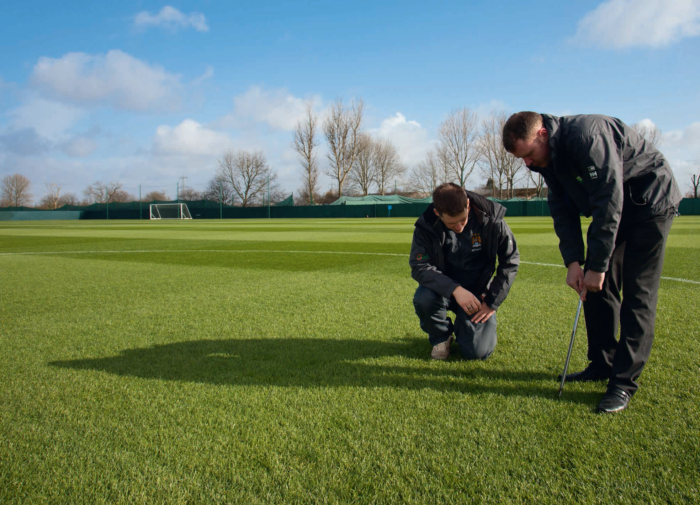Colman Warde, Everris Country Manager Ireland, details how effective soil sampling and testing can be utilised to underpin an efficient turfgrass fertilising programme.
Euro for euro, fertilisation does more to improve poor quality turfgrass or to maintain good-quality turfgrass than any other management practice. Proper fertilisation practices produce a dense turf that resists pests and environmental stresses.
Careless application techniques or excessive amounts of fertiliser applied at the wrong time of year can result in serious turf damage and contamination of water resources.
Like all good decisions, correct fertiliser choice and application rates are based on accurate data. Although poor performing turf can indicate underlying soil problems, one cannot identify soil pH and nutrient problems by sight. Soil analyses are needed to determine if these factors are limiting grass rooting and nutrient uptake. If so, fertilisers are then recommended to rectify these nutrient levels.
Here are some guidelines for proper soil testing.
TAKE A PROPER SAMPLE
A sample that adequately represents the soil area of interest is key. Soil pH and nutrient levels can be extremely variable naturally, due to non-uniform applications of fertiliser and water. I have heard of pH variance between 6.0 and 8.5 within a single golf fairway due to differences in soil type. So, many samples across the entire site are required. If there are specific problem areas, there needs to be a composite sample taken as a sample taken from a full fairway, would lead to a confusing and improper reflection of the problem area.
SAMPLING TECHNIQUES
Take fifteen to twenty soil cores randomly from throughout each sampling area using a 0.5” to 1.0” soil probe. Samples for pH and nutrients should be taken 6” to 8”(15-20cm) deep prior to turf establishment, but only 3” to 4”(7.5-10cm) deep thereafter. Remove the thatch and turf layer and thoroughly mix the soil cores in a clean plastic bucket. Then fill a soil sampling kit box to the top with the sample and discard the excess.
Annual soil sampling is recommended for native soils but more frequent sampling may be prudent on sand-based rootzones. Soil pH and nutrients levels can change rapidly on greens and tees, particularly when recently constructed. Seasonal variation in soil pH does occur, so standardising the time of sampling is a benefit to tracking the changes from year to year. Soil samples do not need to be dry before posting to the laboratory, but excessively wet samples should be air-dried to a moist condition prior to shipping.
The best time to sample is when you can take the time to do a good job, ideally before autumn or spring fertiliser applications. Do not sample shortly after fertiliser applications or when the soils are excessively wet.
FERTILISER RECOMMENDATIONS FROM SOIL ANALYSIS
Most soil testing laboratories make fertiliser recommendations for the major nutrients, Phosphorus (P), Potassium (K), Calcium (Ca) and Magnesium (Mg), and these recommendations are based on the ‘sufficient levels’ approach. This philosophy acknowledges that, as the soil test level of the nutrient increases, the chance of getting a response to adding that nutrient decreases and the magnitude of the response, if it occurs, is diminished.
At a low soil test nutrient level, a response to adding the nutrient is expected most of the time and the response should be relatively large. Adding the nutrient to soil with a medium level of the nutrient should garner a growth response about half the time, but the enhancement will be less than at low soil test levels.
Maintaining soil test levels in the upper part of the medium category, or the lower part of the high category, is a safe and efficient way to manage P, K, Ca and Mg. Building high soil test levels of P and K will be difficult in sand-based rootzones, especially when recently constructed because the ability to retain these nutrients is very limited.
Soil testing procedures can identify insufficient soil supplies of Manganese (Mn) and Copper (Cu), as well as excessive levels of Cu. Soil pH has such a dramatic effect on Mn availability that it must be used in combination with the soil test Mn level in order to make a fertilizer recommendation. For example, at a soil pH of 7.0, soil test Mn must exceed 9ppm to be sufficient. However, at a pH of 6.0, the only 4ppm is needed. Copper deficiencies in turfgrass are rare, only occurring in organic soils.
It should be noted that high levels of Phosphorus are usually present in the soil but are most tightly bound soil, resulting in little free Phosphorus being available. The Phosphorus in each soil sample is analysed by specialist assays that measure only the available Phosphorus and is, therefore, a true measure of the concentration available to the plant.
Using the Everris Soil Test Kit
The Everris soil analysis kit contains all the components for having six separate soil samples analysed. The laboratories where the samples are tested are independently operated using state of the art technology.
THE RESULTS
The samples are analysed individually for the following:
● pH status of the sample
● CEC Levels (Cation Exchange Capacity relates to the amount of nutrients that can be held and exchanged within the root zone without risk of leaching).
● EC (Electrical Conductivity an indirect measurement of the salt content)
● Organic matter %
● Calcium (exchangeable)
● Magnesium (exchangeable)
● Potassium (exchangeable)
● Sodium (exchangeable)
● Phosphorus (available)
● Sulfur (available)
● Zinc (available)
● Manganese (available)
● Iron(available)
● % Base Saturation
The Base Saturation is defined as ‘the percentage of total CEC occupied by the so-called ‘Base’ Cations such as Ca, Mg, Na and K’. It is an important part of the soil test as it gives an indication as to whether these nutrients are in balance and whether the turfgrass has the correct nutrient availability. The amount of Soil Cations (Bases) can be manipulated by the application of fertiliser in order to create a balanced base saturation within the soil. Base Saturation should range from 50 – 75% Calcium, 11 – 20% Magnesium, 0.5 – 7.7% Potassium, 0 – 5% Sodium with the remainder being Hydrogen at 0 – 30% for optimum turf performance. If the percent Base Saturation falls outside these ranges uptake of nutrients can be affected by ‘ion’ antagonism. For example, high exchangeable Calcium can reduce the uptake of Potassium and Magnesium, likewise high exchangeable Potassium can reduce the uptake of Magnesium. The ratio of Magnesium to Potassium should be greater than 2:1.
Applying results using the iTurf Nutrient Programme
Once the results have been sent back we can then begin to draw up a designated I-Turf Nutrient Programme for that specific site. This is done by discussing the results with the client and drawing up a specific nutrient programme based on their needs and budget.
This takes into consideration the following;
● Turf-type
● Rootzone
● Budget
● Application equipment
● Wear
Every site is different with different groundsmen and greenkeepers having their specific preferences for nutrition amounts and types of inputs. These are all catered for in our recommendations.
Now is an ideal time to take your samples. To obtain your soil analysis kit, contact me. I would be delighted to answer your questions and guide you through the process. ✽
 COLMAN WARDE has been working for in turfgrass and amenity horticulture for over 15 years. He has worked for Everris/Scotts Professional on the Turf Amenity and Horticulture sector for over six years and is County Manager for Ireland. Everris manufacture and supply the highest quality specialised nutrients for turf and horticultural plant protection and grass seed products. COLMAN WARDE has been working for in turfgrass and amenity horticulture for over 15 years. He has worked for Everris/Scotts Professional on the Turf Amenity and Horticulture sector for over six years and is County Manager for Ireland. Everris manufacture and supply the highest quality specialised nutrients for turf and horticultural plant protection and grass seed products.
Contact Colman at Tel:+353 (0)87 779 9527; E-mail: colman.warde@everris.com; www.everris.ie |







